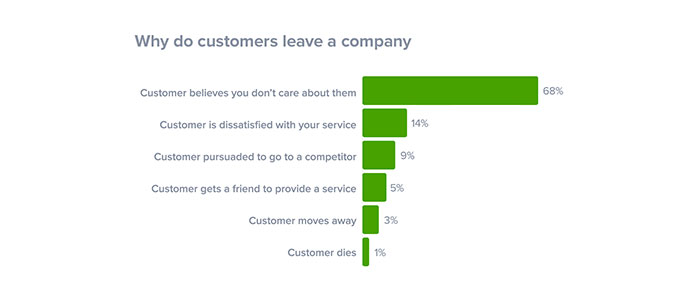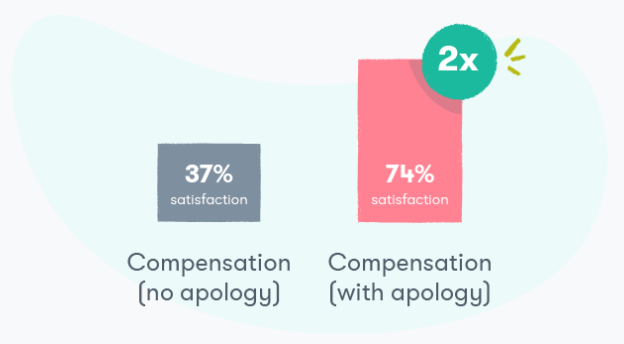How to Deal with Rude Customers: Strategies & Tips
- February 19, 2020
- 13 mins read
- Listen

Table of Content
How to deal with rude customers? This question could be unpleasant as well as frustrating for any business. The receiving end of a tirade is not a happy place to be, especially when the situation isn’t your fault. It is also challenging to handle customers effectively who are upset due to bad experience with your business.
Studies show that increasing levels of psychological abuse inflicted by customers can damage brand performance in the long run by eroding management’s ability to retain valued staff members who can’t handle the stress.
To handle rude customers is an unfortunate reality no matter what type of business you operate. But the question is why are customers so rude?
The below image answers the key reasons for the rude behavior of customers.
Rude customers are those who are highly dissatisfied with the overall interaction with your brand. The first bad experience brings in frustration and annoyance that converts into rudeness if not handled in the right way or time.
Key reasons why customers are so rude
Customers are usually pretty up-front with their feelings when brands fail to meet their expectations. Here are five reasons why customers show stupid behavior.
- Product issues – When there is a gap between customer expectations of your product and the reality, they feel cheated.
- Bad customer service – When businesses fail to meet customer expectations in terms of the quality of service, response time, or overall customer experience.
- Not listening – Active listening is a key attribute of superior customer service. Lack of listening makes customers feel unheard and disregarded.
- Failed promises – Not being able to keep your word might cause displeasure and develop rudeness in your customers. Make sure to compensate and apologize when you fail to keep your word.
- Poor customer experience – At times, businesses fail to meet the expected level of customer experience because of rude staff or a poor in-store or online experience.
How rude customers can affect your business?
Unhappy or frustrated customers can seriously impact the overall health of your business. In the short term, it can affect sales, and in the long term, it can affect your business in a myriad of ways such as damaging brand reputation.
The key areas annoyed customers can impact your business are:
- Higher churn rate – Like great experiences that bring your customers back to you, on the other hand, ends up with higher churn rates. Hence, delivering expected service to customers becomes crucial to stop them from switching to other brands.
- Affect brand loyalty – Rude customers leave your company after the first bad experience and thus have less lifetime value. Loyalty is closely related to brand reputation and losing loyal customers is not a fair game.
- Lower sales – If you do not handle your rude customers properly, they can affect sales by sharing their experience with negative word of mouth.
How to deal with rude customers: Strategies & Tips
As with everything else, dealing with customers relates to “better safe than sorry”. When planning your brand policy, you need to have ready strategies on how to deal with rude customers before they happen. Let us dive into key tips & strategies of identifying and dealing with rude customers.
1. Deliver better customer service
Customers always remember brands by the kind of services they offer. If your customer service strategy is not structured well, you will lose business no matter how good your product is or how proficient your team is. According to Khoros, 65% of customers said they had changed to a different brand because of a poor experience.
Training your customer support team to offer better service can go a long way in preventing customers from getting irritated, which normally escalates into rudeness.
Here are some key elements for you to include in your customer service training:
Offer real-time support
The first customer experience goes a long way. Whether good or bad, it leaves a lasting impression of the experience that decides customer loyalty. One of the important aspects of great customer experience is real time support. And when businesses are able to meet their expectations it is a win-win situation for them.
You can deliver real-time sales and support assistance to your customers with live chat. It helps you to deliver proactive support by understanding the customer journey. With live assistance tools like co-browsing & video chat, you can identify issues faster and deliver personalized solutions in the first contact.
Prepare scripts for common FAQs
Every business encounters rude customers at some point. You can prepare scripted responses based on such encounters. The support team can use these scripts when they encounter such customers. One thing the team needs to ensure while using canned responses is to be aware of using a suitable script that works best for dealing with rude customers.
Don’t get personal – stay calm
No one likes to be shouted at or dismissed. Training programs should focus on helping your team to stay calm in heated situations. It helps agents develop strategies to pacify the situation without doing things that could irritate the customer further. Agents should keep their feelings aside while handling rude customers.
Avoid blame game
All your employees and new hires should be trained to avoid using language that blames the customer or the company. Blaming the customer directly, even if it is their fault is an obvious way to irate them. Instead, the employee can say, “I’m really sorry, there seems to be a mistake and we’ll try to fix it immediately.” Such a response appeases the rude customers that you have acknowledged – something has gone wrong and you will try your best to fix it.
2. Try to keep your promises
Promises always come with the peril of non-performance. It is a bad plan in life as well as business to promise more than you can deliver. If you expect your customers to believe your promises tomorrow, it helps a great deal if you kept them yesterday.
Gallup research and development survey of more than 3,100 customers, less than half of current customers felt that the brands they use to keep the promises they make.
Here are some tips on how to train employees to handle customers who show their displeasure:
Apologize immediately
Where customers are angry and become rude and it’s no fault of your business, the apology should center on the customers’ feelings. Your team should say something along the lines of “I am sorry you feel this way”. You can see the power of an apology. When the business added an apology on top of the compensation, satisfaction doubled to 74%.
Take the right action
Training your customer support staff to try to calm down frustrated customers by showing understanding and saying the right things is only part of the solution. Rude customers who have been legitimately let down by your business will only truly value one thing – they need action.
Show your care and concern
It becomes more important to acknowledge when customers become rude. You should put yourself in the customers’ shoes and imagine the scenario. For instance, they would obviously feel disappointed if they were expecting to receive an item as promised and found that it wasn’t available. Understanding why the customer is disappointed will go a long way in calming them down.
3. Always listen to your customers
If you want to gain mastery on how to deal with customers then you have to listen to them first. It is a great opportunity to make your customers feel comfortable, valued, and appreciated. Always listen to what they say. Try to read between lines to figure out what the actual problem is. Without listening to your customers you will never know the problem or the complexity of the issue.
75% of consumers have advised that they would buy from businesses who know their names.
Customers want to feel like they’re being heard and when they do not feel so they are likely to share their feelings both in person and online in unpleasant ways.
Best practices for listening to rude customers:
Practice active listening skills
Listening is one of the best ways to start to serve rude customers. Train your support team to practice active listening in combative situations. Active listening makes a mindful effort to hear not only the words being spoken but to understand the complete message and context behind the words. Listening helps to figure out what exactly your customers want, their opinions, feedback, etc.
Do not interrupt your customers
If a customer’s frustration has transitioned into rudeness, they will probably have a lot to say. Train your employees to let the customers speak out everything they want. The ‘no interruption’ rule is to be followed by your team until the customers become abusive.
Use positive language
It is very important to choose positive words while interacting with rude customers. Generally, customers switch brands because they are put off by untrained support professionals. 70% of the customer’s journey is dictated by how the customer feels they are being treated. The well trained efficient representatives can make irate customers fall in love with your brand.
The phrases to be used: my apologies, you’re welcome, I can understand why you’d feel that way. Let’s see what can be done now etc.
The phrases to be avoided: I don’t know, please calm down, no problem, etc.
4. Improve your customer experience
There are many instances when a business fails to live up to an expected level of customer experience. The reasons could be arrogant support staff who do not value their treat customers or poor retail or online experience.
Although the customer isn’t always right, it’s up to businesses to provide the best possible customer experience by following the best practices below:
Acknowledge the issue quickly
When customers reach out to you with any issue or complaint it becomes critical to acknowledge them. Acknowledging the issue quickly makes customers feel happy and wait for the resolution.
Creating effortless design
Make it super easy for your customers to navigate you both online and offline. Use visual merchandising to create an appealing aura. Every step should be taken to reduce customers’ frustration. The fewer obstructions to customer satisfaction, the less likely that customers will get irritated.
Escalate to the right team for immediate resolution
Just imagine saying “NO” to an angry customer. It will entirely diminish the value of your support service. Not every time you can handle customers’ queries but it is about how beautifully you say NO.
If you don’t know how to deal with rude customers it will even frustrate them more. In such scenarios, you can follow the scripts like – “Before I answer your question, I need to check a few things on my side. Can I follow-up with you later today?”
5. Implement customer feedback
Collecting customer feedback is not just enough but acting on it is even more important to improve the brand and deliver better customer service.
Let take the example of Disney, known for their excellent customer support, have a great approach to service recovery. It is a five-step process, with easy acronym H.E.A.R.D.
- H- hear
- E- empathize
- A- apologize
- R- resolve
- D- diagnose
Good customer service is about taking out the best opportunity out of the customer’s complaints or feedback and using it to improve the bonding with your customers. The best practices to be followed are:
- Discuss the feedback internally to have a better understanding and improve upon customer pain points.
- You can provide incentives to customers for providing feedback like appreciate them in social media, send a good bag to make feel special.
- Once the feedback is fixed, convert it into tutorials or notes for better self service of customers.
Measure your customer satisfaction
One of the important aspects of dealing with rude customers efficiently is to measure your customer satisfaction level. The metrics are the performance measurement used by the support teams to monitor, analyze and take necessary actions to enhance customer service success.
The key KPIs are Customer Satisfaction Score (CSAT), Average Response Time (ART), First Contact Resolution (FCR), Number of touchpoints.
The higher the CSAT score the better is your customer satisfaction. You can compare the scores with the customer feedback collected to know what is or is not working.
6. Focus on training customer service team
Dealing with unhappy customers can be difficult, particularly if your support team has not been provided with a standard protocol for handling stupid customers. Training your customer service team on how to deal with rude customers appropriately and empowering them to offer quick resolutions will help you retain them as well as improve their satisfaction with your brand.
Imparting the customer service etiquettes to the team helps to make every customer interaction deliver an optimal experience.
Best practices for training your customer support staff:
- Outline the procedures to address the annoyed customers. Provide a series of solutions that are acceptable to the scenarios.
- Include the common steps (thanking the customer for contacting the company, apologizing to the customer for any inconvenience, etc.) of the procedure during the training sessions.
- Include good and bad examples of customer complaints and service representative responses as a part of the training. Ask employees to role-play the scenario for an effective employee training program.
7. Lack of proper follow up
Follow up with your customers is very important to ensure their issues were resolved properly and that they were satisfied with the service.
Following up helps your customers know you really care for them and you are on their side. The best practices to keep the follow up process streamlined are:
Set autoresponder to acknowledge customer issues
Service level agreement (SLA) is very important to be defined as it serves as an acknowledgment to the customer query. When customers are aware that their problem is being looked into they are happily waiting for a resolution.
Make your support team accountable
Accountability is important for any team. You should make sure that your support team is accountable to know how they are performing to deliver great customer experience to the customers.
Measure metrics regularly
Measure the key customer service metrics such as average response time, first contact resolution, CSAT score on a regular basis. The scores will help you to know if your customer satisfaction graph is fluctuating.
Conclusion
Rude customers are inevitable. But how you deal with rude customers defines your business in the long run. Handling them is actually an important part of the customer life-cycle. By using the right tools and strategies, you can easily convert your unhappy customers to loyal customers.
The unhappy customers are unreasonable, unfriendly, and may use offensive language or behavior. But you as a business have to serve your customers, so it is important to try to help them. While dealing with rude customers, it is crucial to control your own emotions and to counteract their aggressive behavior with calm, positive responses.






